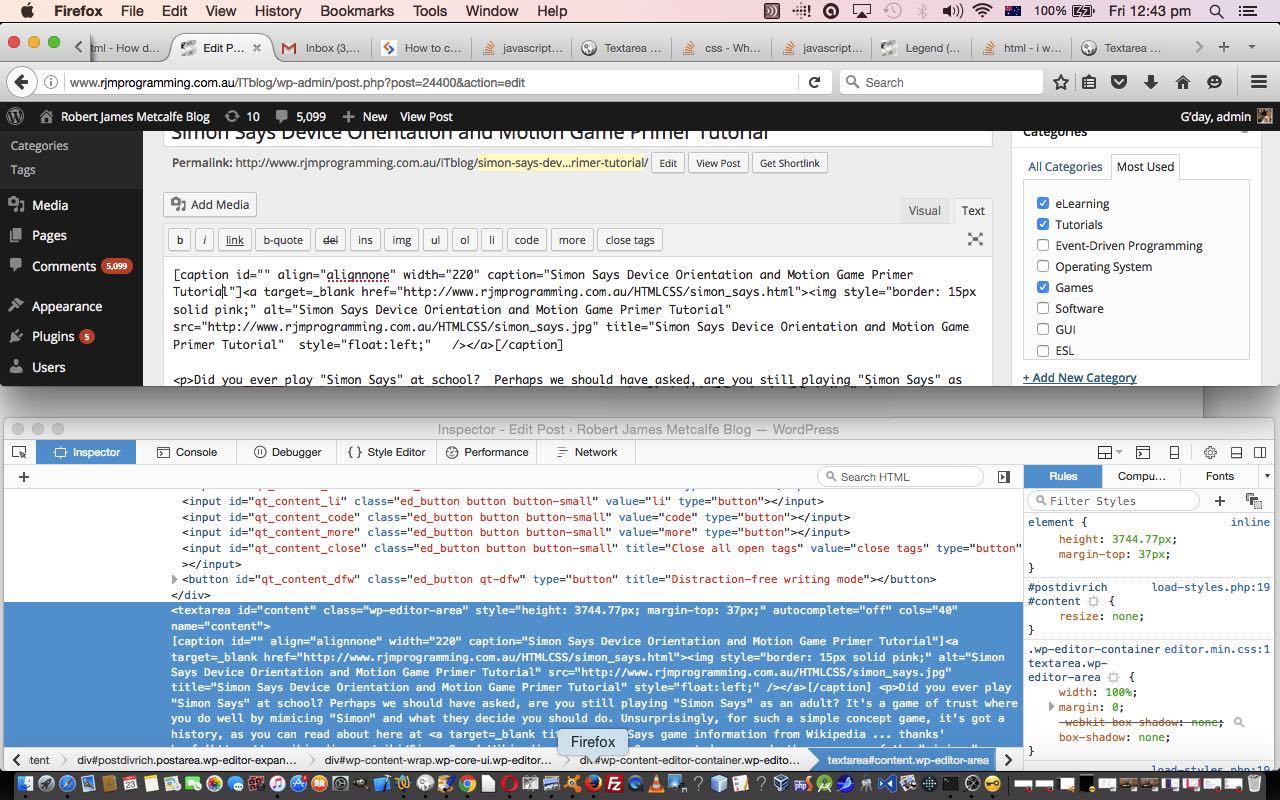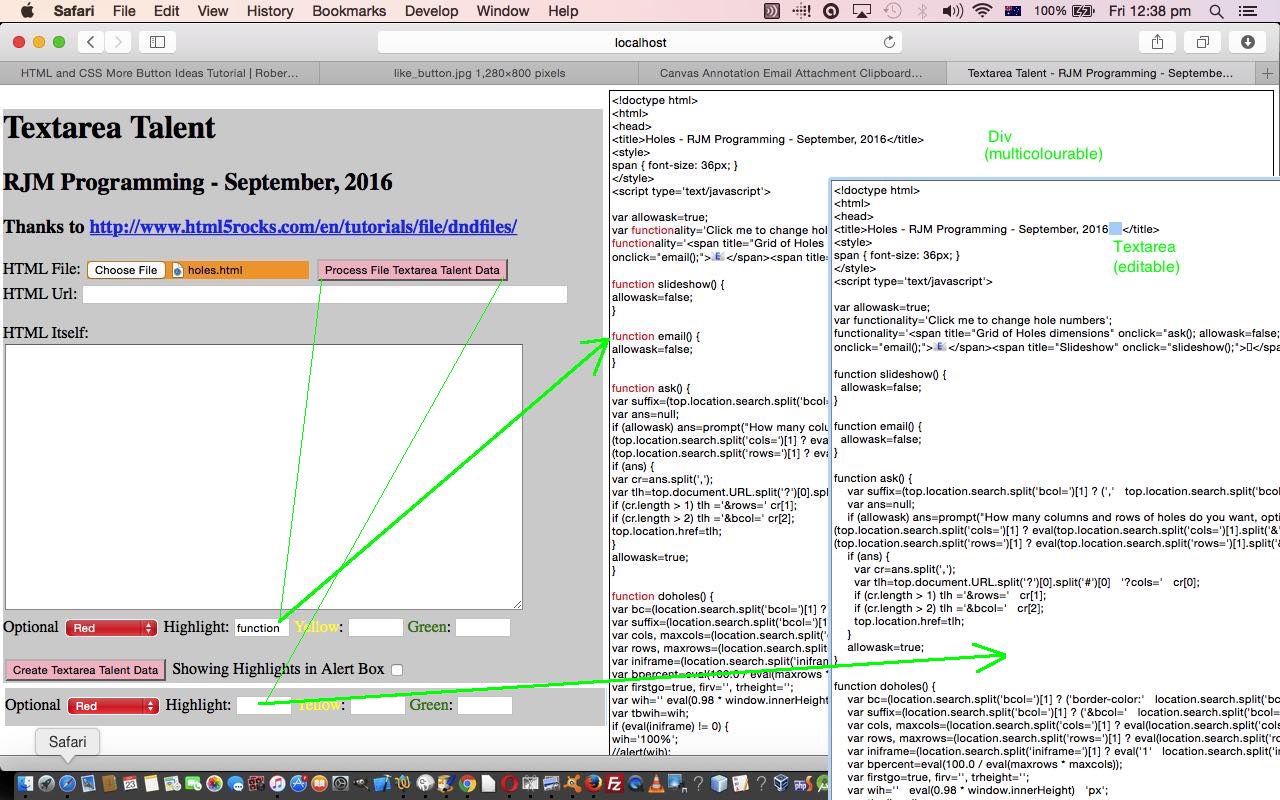It’s not as if we haven’t talked about it before, as evidenced by HTML Textarea and Div Talents Primer Tutorial as shown below, but we think the HTML div element is hugely useful. If you ever …
- surf the “net” … and …
- come across a website whose design appeals to you … then you discover …
- via the browser’s View -> Page Source (or equivalent) functionality … that …
- most/all of the webpage’s document.body.innerHTML is made up of a “jigsaw” of HTML div element components
… you would not be alone. Personally, we think more in terms of HTML table thoughts, “by design” default, as much as anything because of the horizontal alignment simplicity of the HTML table element, but even we recognize how good an HTML div “jigsaw” of a webpage can be, as much as anything because there is nothing stopping those HTML div “jigsaw” parts containing our favoured HTML table element content within them, as for today’s “proof of concept” web application we’ve created.
This web application today features …
- aforesaid mentioned HTML div “jigsaw” (2D look as HTML code and a pile of pieces piled up in Z in 3D when displayed) parts makeup of the webpage’s document.body.innerHTML … combined with …
- “overlay” CSS and Javascript DOM logic to treat 3 major HTML div “jigsaw” parts as like 3 separate HTML webpages, but in the one webpage … two of the the CSS “overlay” usual suspects (no opacity needed today) coming into play were …
- position:absolute property
- z-index
… effectively …
- acting like Ajax, in navigational terms, in that we don’t leave the webpage we are on … yet …
- all the benefits of “overlay” design allows for the Javascript DOM dynamic manipulation (to the extent that they can even be “blanked” as necessary) and changing of any/all of these 3 major HTML div “jigsaw” parts
Today’s web application also uses HTML a element links with an interesting interplay between the …
- CSS (complex) pseudo class selectors we talked about at CSS and HTML Complex Pseudo Class Selectors Tutorial as in …
<style>
a { cursor: pointer; text-decoration: underline; margin: 15px 15px 15px 15px; background-color: white; }
a:hover { background-color: lightgreen; }
a[title="1"]:hover { background-color: yellow; }
a[title="2"]:hover { background-color: pink; }
a[title="3"]:hover { background-color: lightblue; }
td { border: 50px solid red; }
</style>
… and … - Javascript DOM, kicked off by a document.body onload event (though we could easily have hardcoded it) that added HTML a link titles equivalent to their innerHTML (content) property values, in order to “hook into” the CSS (complex) pseudo class selectors above for a colour coded onmouseover feel for all those non-mobile platform users out there …
function ahelper() {
var a_s=document.getElementsByTagName('a');
for (var i_a_s=0; i_a_s<a_s.length; i_a_s++) {
if (('' + a_s[i_a_s].title) == '') {
a_s[i_a_s].title=a_s[i_a_s].innerHTML;
}
}
}
</script>
<body style='background-color: yellow;' onload='ahelper();'>
This, then, is both an “overlay” scenario, and a webpage navigation design idea. As a “proof of concept”, we don’t do much detail with the content but rest assured the div_overlay_navigation.html HTML programming source control’s live run can be used to spark your imagination in “finger on the keyboard” action, we hope, and try out some of the ideas for yourself, perhaps?! Good luck, if so.
Previous relevant HTML Textarea and Div Talents Primer Tutorial is shown below.
We faced a dilemma today with the name of our web application, and ended up with textarea_talent.html (along with its business logic external Javascript textarea_talent.js), but as the project went along we were torn towards a name of div_talent.html and div_talent.js as we shall explain below.
We understand the great role the HTML textarea element has in CMS (Content Management Systems) work, and we illustrate this below with (a) WordPress (blog as an example) …

It’s crucial for getting HTML or non-caretted Text (that is internally turned into HTML behind the scenes) … via those wonderful tabs … off the user and onto the MySql database, and then out to the client user as part of a webpage. Out at that webpage, though, we’ve no doubt this content is embedded in an HTML div element, the other “talent” here.
But their strengths and weaknesses go like this, at least to us, in the limited HTML text view of things …
| Text Functionality Issue | HTML Element Type | Strength | Weakness (where a “Yes” is like … “Oh No!”) |
|---|---|---|---|
| Display Monocolour Text | Textarea | Yes | |
| Div | Yes | ||
| Display Editable Text | Textarea | Yes | |
| Div | Yes | ||
| Display Multicolour Text | Textarea | Yes | |
| Div | Yes | ||
Our web application today is like an inhouse version of (a web browser) View Page Source type of arrangement, but allowing, optionally, for the highlighting of words. The “highlighting of words” functionality needed the HTML div element to come into the equation, otherwise the “talents” of an HTML textarea element would have sufficed, and are normally preferred, for those editing reasons. By the way, an HTML textarea element given a readonly property stops the user changing an HTML textarea element’s contents, should that be what you require.
Another issue came into play as a “subtheme” of today’s tutorial. Are you aware that some HTML elements, such as …
Textarea elements do not, by default, inherit CSS styling settings of the webpage Body element
… which means, without Javascript DOM programmatic intervention the text shown in an HTML textarea element will differ greatly in its appearance to that of an HTML div element. This annoyed us enough to warrant some research and development on this topic and found that the idea to have both HTML div and textarea elements to be mapped to the inherited look of the HTML body element, that you might attempt to do via CSS like …
<style>
textarea, div {
font-family: inherit;
font-size: inherit;
}
</style>
… was not nearly so effective a thing to do, as to put in the hard yards to “purloin” the styling characteristics of one HTML element type and “slap” those characteristics, via Javascript DOM, onto the other HTML element type of interest, via code (snippet) like used today (with its “thank you” implied link), as per …
function copyTextareaStyling() {
var output = document.getElementById("tarea"), divelem = document.getElementById("tareadiv");
if (divelem) { // thanks to ideas off http://stackoverflow.com/questions/12266320/copy-div-content-to-textarea-or-text-with-the-same-font-family-style
divelem.style.fontFamily = window.getComputedStyle(output,null).fontFamily || output.style.fontFamily || output.currentStyle.getCurrentProperty('font-family');
divelem.style.fontSize = window.getComputedStyle(output,null).fontSize || output.style.fontSize || output.currentStyle.getCurrentProperty('font-size');
divelem.style.border = window.getComputedStyle(output,null).border || output.style.border || output.currentStyle.getCurrentProperty('border');
divelem.style.padding = window.getComputedStyle(output,null).padding || output.style.padding || output.currentStyle.getCurrentProperty('padding');
divelem.style.margin = window.getComputedStyle(output,null).margin || output.style.margin || output.currentStyle.getCurrentProperty('margin');
divelem.style.overflow = window.getComputedStyle(output,null).overflow || output.style.overflow || output.currentStyle.getCurrentProperty('overflow');
}
}
… via the wonders of the Javascript window.getComputedStyle() method that we have mentioned before a few times at this blog.
Maybe you are a regular at this blog, and recognize the look of today’s live run web application? Yes, a lot of the ideas emanating from Legend for and from HTML Map Element Web Server Tutorial thread of blog postings went into the “purloinment” … nga, nga .. nga nga … ngaaa … it is a word … exercise done on legend_via_map.htm‘s code in this way mostly to do with the virtuous decision to hive off specific business logic to the external Javascript textarea_talent.js.
If this was interesting you may be interested in this too.
If this was interesting you may be interested in this too.




